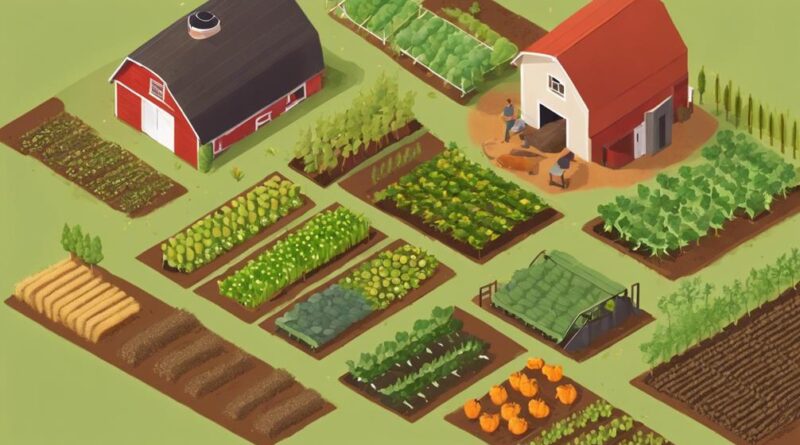3 Best Eco-Friendly Farming Techniques for Climate Health
Enhance climate health with regenerative agriculture, crop rotation, and agroforestry. Regenerative agriculture boosts soil health and biodiversity, promotes carbon sequestration, and utilizes diverse crop rotations. Crop rotation optimizes soil health, prevents depletion, and enhances productivity. Agroforestry integrates trees for biodiversity and resilience, improving soil health and offering extra income streams. Implementing these techniques can significantly benefit the environment and agriculture.
Regenerative Agriculture
Implementing regenerative agriculture practices can significantly improve soil health and biodiversity on farms. By focusing on regenerative techniques such as minimal soil disturbance, diverse crop rotations, and the use of cover crops, farmers can enhance the health of their soil and promote carbon sequestration.
Soil health is a crucial aspect of sustainable agriculture. Through regenerative practices, farmers can increase soil organic matter, improve soil structure, and enhance nutrient cycling. This leads to better water retention, reduced erosion, and increased microbial activity in the soil. Studies have shown that regenerative agriculture can significantly boost soil health indicators such as soil organic carbon levels, microbial biomass, and overall soil fertility.
One of the key benefits of regenerative agriculture is carbon sequestration. By using practices that promote the capture and storage of carbon in the soil, farmers can play a vital role in mitigating climate change. Cover crops, no-till farming, and agroforestry are all effective methods for sequestering carbon in the soil. Research has demonstrated that regenerative agriculture practices have the potential to sequester large amounts of carbon, helping to offset greenhouse gas emissions and contribute to climate change mitigation efforts.
Crop Rotation
Crop rotation is a fundamental practice in sustainable farming that optimizes soil health and crop productivity through strategic plant sequencing. By rotating different crops seasonally, you can prevent soil depletion, control pests and diseases, and improve soil structure. This method helps maintain soil health by diversifying the nutrient needs of plants, reducing the buildup of pathogens, and enhancing beneficial microbial populations in the soil.
One of the key benefits of crop rotation is its positive impact on soil health. Different crops have varying nutrient requirements, and rotating them helps prevent the depletion of specific nutrients from the soil. For example, legumes in rotation can fix atmospheric nitrogen, enriching the soil naturally. This process enhances soil fertility and reduces the need for synthetic fertilizers, promoting a more sustainable farming system.
Crop rotation also contributes to water conservation by improving soil structure and water retention capacity. Deep-rooted crops like corn followed by shallow-rooted crops like soybeans can help break up hardpans, allowing water to infiltrate the soil more easily. This reduces runoff and erosion while promoting better water distribution for plant growth.
Agroforestry
Optimizing land use for enhanced sustainability, agroforestry integrates trees and shrubs into agricultural systems to diversify yields and promote ecological resilience. This practice goes beyond traditional monoculture farming by incorporating woody perennials that offer a range of benefits. One key advantage of agroforestry is tree planting, which helps combat climate change through carbon sequestration. Trees absorb carbon dioxide from the atmosphere, storing carbon in their biomass and the soil, thus mitigating greenhouse gas emissions.
Research indicates that agroforestry systems have the potential to sequester significant amounts of carbon. For instance, a study published in the journal 'Environmental Research Letters' found that agroforestry practices could sequester up to 173 tons of carbon per hectare over a 20-year period. This demonstrates the substantial carbon sequestration capacity of integrating trees into agricultural landscapes.
Furthermore, agroforestry not only contributes to climate change mitigation but also enhances biodiversity, improves soil health, and provides additional sources of income for farmers. By diversifying crops with trees and shrubs, farmers can create more resilient and sustainable agricultural systems. Embracing agroforestry practices can lead to long-term environmental benefits while supporting food security and economic stability in farming communities.
Conclusion
In conclusion, adopting regenerative agriculture, crop rotation, and agroforestry techniques can significantly contribute to climate health and sustainability in farming practices.
These eco-friendly methods not only help reduce greenhouse gas emissions and preserve soil quality but also promote biodiversity and overall ecosystem health.
By implementing these proven techniques, farmers can play a crucial role in mitigating the impacts of climate change and ensuring a more resilient and sustainable future for agriculture.
